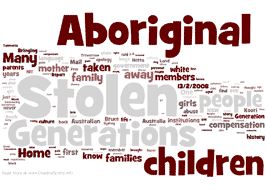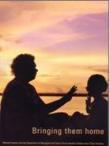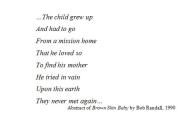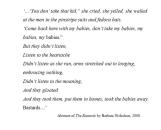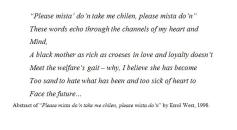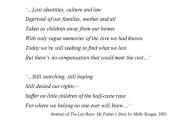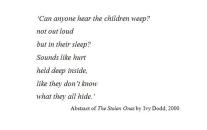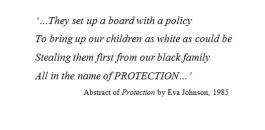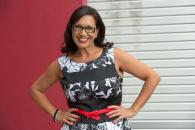AustLit
-
The following trail is linked to the The BlackWords Essays by Dr Anita Heiss, published by AustLit in 2015. They bring together the works, authors and organisations that are mentioned in the essays and support the teaching and incorporation of Aboriginal and Torres Strait Islander texts in teaching and general reading.
-
'Denial of identity, the heartache and pain of loss, and the physical removal from family, cultural practices and familiar surrounds were all part of the process of assimilating Aboriginal people into white society. This process of ‘disconnection’ was a significant strategy in Government policies of ‘protection’ in the 1800s, right through until the late 1960s.'
'Under a range of Government Acts and Policies of Protection carried out through the States and Territories of Australia, a community of removed children known as the Stolen Generations was created.' (Heiss, Anita, BlackWords: Our truths - Aboriginal writers and the Stolen Generations, 2015)
-
‘In New South Wales there was a government body called the Aborigines Protection Board which was set up in 1883. In 1940 the Aborigine Protection Board changed its name to the Aborigines Welfare Board and they controlled Aborigines until 1969. There was one of these kinds of Boards in every state and territory of Australia. These boards thought that the only way Aboriginal children would have a good life was to take them away from their families to be raised in white families or orphanages, even though their real parents didn’t want them to go.’
‘…Testimonies in the Australian Government’s Bringing Them Home: The 'Stolen Children' Report (1997) highlight the dramatic impact of policies of protection on both individuals and families. The effects of separation on children included traumatic loss; lives of anguish and social malformation; growing up starved of affection; emotional and physical abuse; and training for girls with the expectation that many would become domestic servants; and, for boys, that they would become stockmen, or learn a simple trade. Stolen children were taught to stay away from Aboriginal people and learned to be ashamed that they were black. The Children of the Stolen Generations were left in the middle because while they were made to feel too ashamed to join their Aboriginal communities, there were also rejected by the white community into which they were meant to be assimilated.’
‘…Many of the Stolen Children, now in adult life, have used the pen as means of healing the scars of removal, of telling their own stories of survival, and of trying to describe the enormous impact such policies had, and continue to have, on Aboriginal lives. They aim to provide a voice for Aboriginal Australia in telling the history of our country; a country that, until the formal Government Apology by the then Prime Ministers Kevin Rudd in 2008, had denied the Stolen Generations even existed.’
‘Our words, our books, our poems, our plays are ‘our truths’.’
‘There is a long list of works across a range of genres covering the various experiences of being forcibly removed. Over 470 individual works by more than 350 people have been indexed into the AustLit BlackWords dataset related to the subject of Stolen Generations. Below are a few key texts to give some foundation to understanding the reality of forced removal of Aboriginal children as told by Aboriginal people…’ (Heiss, Anita, BlackWords: Our truths - Aboriginal writers and the Stolen Generations, 2015)
-
Many one-time Aboriginal authors are those who write their autobiographies or memoirs or have their story told through biography. These personal accounts often unravel the painful experience of being removed under Acts of Protection nationally.’ (Heiss, Anita, BlackWords: Our truths - Aboriginal writers and the Stolen Generations, 2015)
-
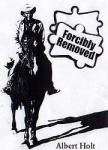 Image courtesy of Magabala Books'... Forcibly Removed is a personal story told with humour and a confidence that comes from experience and achievement. It reveals the journey of a spirited family who maintained their dignity and fought to survive while living on Cherbourg Mission, Queensland, in the mid-20th century.' (Backcover). (...more)See full AustLit entry
Image courtesy of Magabala Books'... Forcibly Removed is a personal story told with humour and a confidence that comes from experience and achievement. It reveals the journey of a spirited family who maintained their dignity and fought to survive while living on Cherbourg Mission, Queensland, in the mid-20th century.' (Backcover). (...more)See full AustLit entry -
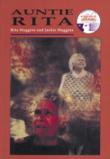 Cover image courtesy the publisher.See full AustLit entry
Cover image courtesy the publisher.See full AustLit entry"Most people call me Auntie Rita, whites as well as Aboriginal people. Auntie is a term of respect of our older women folk. You don't have to be blood-related or anything. Everyone is kin. That's a beautiful thing because in this way no one is ever truly alone, they always have someone they can turn to."
Rita Huggins told her memories to her daughter Jackie, and some of their conversation is in this book. We witness their intimacy, their similarities and their differences, the '"fighting with their tongues".
(...more) -
See full AustLit entry
'...I was about five years old when I left the mission, but I can still remember events which must have occurred much earlier than my five-year-old memory...'
(...more)A Short story.
-
‘Some consider teaching young people about the Stolen Generations as something too serious, too dark, or too emotional for children. Perhaps some think that it is too difficult a subject for kids to grasp in the classroom, especially in the 21st century. Firstly, it is the responsibility of educators to ensure Australian students know a complete and inclusive version of Australian history, their shared history. Secondly, our ability to be humane is drawn from our ability to empathise and understand the lives of others, particularly those the same age as us, in different geographic locations and at different moments of time in history.’ (Heiss, Anita, BlackWords: Our truths - Aboriginal writers and the Stolen Generations, 2015)
-
Down the Hole, Up the Tree, Across the Sandhills : Running From the State and Daisy Bates by Edna Tantjingu Williams, and Eileen Wani Wingfield; illustrated by Kunyi June-Anne McInerney
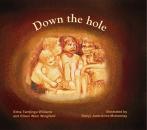 Cover image courtesy of publisher.'In the stark desert mining town of Coober Pedy when the government people came to take the fair-skinned Aboriginal children away they didn't always find them. They were down the hole up the tree across the sandhills . . . running from the State and Daisy Bates. This beautifully illustrated children's picture book is a true story. Includes informative historical and cultural supplementary material.' Source: Publisher's blurb (...more)See full AustLit entry
Cover image courtesy of publisher.'In the stark desert mining town of Coober Pedy when the government people came to take the fair-skinned Aboriginal children away they didn't always find them. They were down the hole up the tree across the sandhills . . . running from the State and Daisy Bates. This beautifully illustrated children's picture book is a true story. Includes informative historical and cultural supplementary material.' Source: Publisher's blurb (...more)See full AustLit entry -
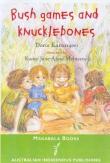 This image has been sourced from online."Bush Games and Knucklebones is a very special collaboration between best-selling author Doris Kartinyeri and well-known artist Kunyi June-Anne McInerney, who both spent time at Colebrook Childrens' home in South Australia in the 1950s." (Magabala Books website) (...more)See full AustLit entry
This image has been sourced from online."Bush Games and Knucklebones is a very special collaboration between best-selling author Doris Kartinyeri and well-known artist Kunyi June-Anne McInerney, who both spent time at Colebrook Childrens' home in South Australia in the 1950s." (Magabala Books website) (...more)See full AustLit entryThis work is in English and Aboriginal Pitjantjatjara languages.
-
First two lines of poem: 'Yaaawee, yaahaawawee, My brown skin baby they take 'im away.'
-
First line of poem: 'You don't take that land,' they cried, they yelled, they wailed'
-
First line of poem: 'Please mist do'n take me chilen, please mista do'n'
-
First line of poem: 'Black people crying dispossession of their land'
-
First line of poem: 'Can anyone hear the children weep'
-
First line of poem: 'In the days when our land and our people were free'
-
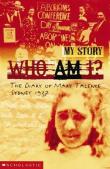 Cover image courtesy the Author.Mary was taken to Bomaderry Aboriginal Children's Home when she was only five years old. Now she's ten years old and living with a white family in Sydney. She doesn't fit in and starts to question why. We live Mary's emotional, psychological and physical journey through her twelve months of diary entries, explaining the collective story of the those members of the Stolen Generation removed under policies of Protection in NSW. The diary format helps to transport readers back through time to 1938 and the lead up to the Sesquintennary and the Day of Mourning Conference and protest in Sydney. (...more)See full AustLit entry
Cover image courtesy the Author.Mary was taken to Bomaderry Aboriginal Children's Home when she was only five years old. Now she's ten years old and living with a white family in Sydney. She doesn't fit in and starts to question why. We live Mary's emotional, psychological and physical journey through her twelve months of diary entries, explaining the collective story of the those members of the Stolen Generation removed under policies of Protection in NSW. The diary format helps to transport readers back through time to 1938 and the lead up to the Sesquintennary and the Day of Mourning Conference and protest in Sydney. (...more)See full AustLit entryA novel in diary form.
-
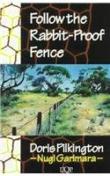 This image has been sourced from online.See full AustLit entry
This image has been sourced from online.See full AustLit entry'The film Rabbit-Proof Fence is based on this true account of Doris Nugi Garimara Pilkington's mother Molly, who as a young girl led her two sisters on an extraordinary 1,600 kilometre walk home. Under Western Australia's invidious removal policy of the 1930s, the girls were taken from their Aboriginal family at Jigalong on the edge of the Little Sandy Desert, and transported halfway across the state to the Native Settlement at Moore River, north of Perth.
(...more)Part of the trilogy: Caprice: A Stockman's Daughter and Under the Wintamarra Tree.
With glossary of Mardujara words. (Mardujara can also be spelt Mardudjara and Martujara)
-
 Screen cap from promotional trailerSee full AustLit entry
Screen cap from promotional trailerSee full AustLit entryBased on real life events that occurred in 1931, Rabbit-Proof Fence is the story of three mixed-race Aboriginal children who are forcibly abducted from their mothers by the Western Australian government. Molly (aged fourteen), her sister Daisy (aged eight), and their cousin Gracie (aged ten) are taken from their homes at Jigalong, situated in the Pilbara region of Western Australia, at the orders of the Protector of Aborigines, A.O. Neville, and sent to an institution at Moore River to be educated and trained as domestic servants.
(...more)Film adaptation of Follow the Rabbit-Proof Fence by Doris Pilkington Garimara
The scene below is 'The stealing of children'
Scene description: As Constable Riggs (Jason Clarke) arrives, Maude (Ningali Lawford) realises he has come to take the children. They run, but Riggs cuts off their escape route and seizes the children one by one. He warns Gracie (Laura Monaghan) to stay in the car or he’ll lock up her mother. Tiny Daisy (Tianna Sansbury) is easier to subdue but the eldest girl, Molly (Everlyn Sampi), fights back. As the police car drives away, the mothers and Molly’s grandmother (Myarn Lawford) are left wailing in the dust.
Warning: May contain names, images or voices of decreased Aboriginal and Torres Strait Islander people.
-
The Stealing of Children from Rabbit Proof Fence
https://www.youtube-nocookie.com/embed/XaZtOIsgBqQ -
 Image courtesy of UQPSee full AustLit entry
Image courtesy of UQPSee full AustLit entry'A story of homecoming, this absorbing novel opens with a young, city-based lawyer setting out on her first visit to ancestral country. Candice arrives at "the place where the rivers meet", the camp of the Eualeyai where in 1918 her grandmother Garibooli was abducted. As Garibooli takes up the story of Candice's Aboriginal family, the twentieth century falls away.
Garibooli, renamed Elizabeth, is sent to work as a housemaid, but marriage soon offers escape from the terror of the master's night-time visits.
(...more)Includes study guide
-
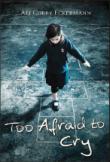 This image has been sourced from Web.See full AustLit entry
This image has been sourced from Web.See full AustLit entry'Too Afraid to Cry is a memoir that, in bare blunt prose and piercingly lyrical verse, gives witness to the human cost of policies that created the Stolen Generations of Indigenous people in Australia.
'It is a narrative of good and evil, terror and happiness, despair and courage. It is the story of a people profoundly wronged, told through the frank eyes of a child, and the troubled mind of that child as an adult, whose life was irretrievably changed by being tricked away from her family and adopted into a German Lutheran family.
(...more)Author's note:
My family and Aboriginal persons
are advised that this story
contains the names of people
who have passed away
-
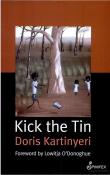 Cover image from Google BooksSee full AustLit entry
Cover image from Google BooksSee full AustLit entry'When Doris Kartinyeri was a month old, her mother died. The family gathered to mourn their loss and welcome the new baby home. But Doris never arrived to live with her family - she was stolen from the hospital and placed in Colebrook Home, where she stayed for the next fourteen years.
The legacy of being a member of the Stolen Generations continued for Doris as she was placed in white homes as a virtual slave, struggled through relationships and suffered with anxiety and mental illness.
(...more)Includes seven pieces of poetry
-
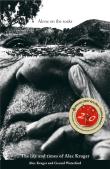 Cover image courtesy of the publisher.See full AustLit entry
Cover image courtesy of the publisher.See full AustLit entry'Alec Kruger was stolen as a child from his family and his country. From this early time he knew the cold and harsh reality of institutions and not the caressing love of his mother or the warmth of other close relations. Still young, he was taken again - to the cattle stations of Central Australia where, even as a boy, he was expected to display all the independence and ingenuity of someone much older. In isolation. Alec faced possible death, till the arrival of Old People from country who saved him, taught him and made him culturally strong.
(...more) -
 Image courtesy of Magabala Books'Brought up an orphan at Forest River Mission, Connie McDonald became a teacher, a missionary in the Church Army and a welfare worker. Her stories recall an era of matrons and missionaries, strict regulations and clothes made out of flour bags. Confronting and suffering racism, Connie kept searching for her place in the world and her family.' (Source: Libraries Australia). (...more)See full AustLit entry
Image courtesy of Magabala Books'Brought up an orphan at Forest River Mission, Connie McDonald became a teacher, a missionary in the Church Army and a welfare worker. Her stories recall an era of matrons and missionaries, strict regulations and clothes made out of flour bags. Confronting and suffering racism, Connie kept searching for her place in the world and her family.' (Source: Libraries Australia). (...more)See full AustLit entry -
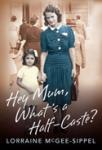 Courtesy of Magabala BooksSee full AustLit entry
Courtesy of Magabala BooksSee full AustLit entry'Lorraine McGee-Sippel was just a small girl when she asked her parents what a half-caste was. It was the 1950s and the first step on a journey that would span decades and lead her to search for her birth family.
'In the historic climate of the Rudd Government's Apology, McGee-Sippel aligns herself with the Stolen Generations as she reveals the far-reaching effects of a government policy that saw her adoptive parents being told their daughter was of Afro-American descent.
'This is not just a story of displacement, but an honest telling that explores the fragility of reconnection, cultural identity, and the triumphs of acceptance.
(...more)Epigraph: My story is not just my story. There is family to consider and I have changed some names for privacy. This is an account of my life as I remember it. People familiar with my story may have a different version. This is mine.
-
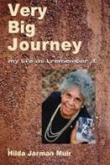 This image has been sourced from online.See full AustLit entry
This image has been sourced from online.See full AustLit entry'Hilda Muir was born on the very frontier of modern Australia, near the outback town of Borroloola in the Northern Territory in about 1920.
'Her early life was spent roaming the Gulf Country on foot, hunting and gathering with her family. Her mother was a Yanyuwa person, and so was Hilda. Known to the clan as 'Jarman', it mattered little that her father was an unknown white man. This small girl had a name, a loving family, and a secure Aboriginal identity.
'Very Big Journey tells of Hilda's bush childhood, and her forced removal from a loving family to the rigours of life in the Kahlin Home.
(...more) -
Stolen Generations Education: Aboriginal Cultural Strengths and Social and Emotional Well Being by Norman Sheehan
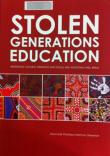 This image has been sourced from Front coverThis workbook, authored by Dr Norman Sheehan and produced by Link-Up (Qld) is aimed to provide information and methods that help novices to engage with Stolen Generations knowledge. Focusing on the work and services of Link-Up (Qld), it outlines 'an Aboriginal Cultural Strengths... social and emotional well being approach to understanding how we got here; how the Stolen Generations came to be a significant part of the history of Queensland, and what this means for human rights, education and the Social and Emotional Well Being. (...more)See full AustLit entry
This image has been sourced from Front coverThis workbook, authored by Dr Norman Sheehan and produced by Link-Up (Qld) is aimed to provide information and methods that help novices to engage with Stolen Generations knowledge. Focusing on the work and services of Link-Up (Qld), it outlines 'an Aboriginal Cultural Strengths... social and emotional well being approach to understanding how we got here; how the Stolen Generations came to be a significant part of the history of Queensland, and what this means for human rights, education and the Social and Emotional Well Being. (...more)See full AustLit entry -
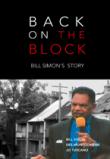 Image courtesy of Publisher websiteSee full AustLit entry
Image courtesy of Publisher websiteSee full AustLit entry'Stolen, beaten, deprived of his liberty and used as child labour, Bill Simon was locked up in the notorious Kinchela Boys Home for 8 years where he was told his mother didn't want him, and that he was 'the scum of the earth'. His experiences there would shape his life forever...
Bill Simon got angry, something which poisoned his life for the next 2 decades. A life of self-abuse and crime which finally saw him imprisoned.. From The Block in Sydney's Redfern, one of the most contentious and misunderstood places in Australia, Bill Simon tells the truth about life in one of Australia's most terrible juvenile institutions, where thousands of boys were warehoused and abused.
(...more) -
 Image courtesy of Creative SpiritsIn an invasive, paternalistic, federal public policy environment for Indigenous communities, this book provides an in-depth account of one person's experiences as a 'Stolen Generation' Aboriginal Australian...The book presents a rare autobiographical journaling of the psychological impact of institutionalisation on an Indigenous woman, her search for family, community and identity, her psychological breakdown and her personal reconstruction through telling her story in a supportive educational environment. (...more)See full AustLit entry
Image courtesy of Creative SpiritsIn an invasive, paternalistic, federal public policy environment for Indigenous communities, this book provides an in-depth account of one person's experiences as a 'Stolen Generation' Aboriginal Australian...The book presents a rare autobiographical journaling of the psychological impact of institutionalisation on an Indigenous woman, her search for family, community and identity, her psychological breakdown and her personal reconstruction through telling her story in a supportive educational environment. (...more)See full AustLit entry -
No Options, No Choice!: The Moore River Experience : My Father, Thomas Corbett, an Aboriginal Half-Caste. Thomas Corbett's narrative, recorded and adapted by his daughter, Rosemary van den Berg.
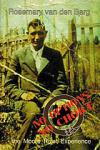 Image courtesy of Magabala Books'Autobiography of Thomas Corbett as told to his daughter; born 1910 in the Pilbara, removed from his mother and taken to Moore River Settlement; working life in the south west of Western Australia; labouring and stock work; return to Moore River; marriage and family; final move from Moore River to Pinjarra in 1944.' Source: http://www.aiatsis.gov.au/library/ (Sighted: 01/07/2009). (...more)See full AustLit entry
Image courtesy of Magabala Books'Autobiography of Thomas Corbett as told to his daughter; born 1910 in the Pilbara, removed from his mother and taken to Moore River Settlement; working life in the south west of Western Australia; labouring and stock work; return to Moore River; marriage and family; final move from Moore River to Pinjarra in 1944.' Source: http://www.aiatsis.gov.au/library/ (Sighted: 01/07/2009). (...more)See full AustLit entry -
 Image courtesy of Magabala BooksSee full AustLit entry
Image courtesy of Magabala BooksSee full AustLit entryGlenyse Ward was taken from her mother and put into Wandering Mission to grow up in a regimented and enclosed world of German nuns. At sixteen, again without choice, she was sent to a wealthy farm to be little better than a slave. Soon, she was wishing shoe was back at the mission...' (Source: Back cover)
(...more)Dedication:
For my mother, husband and children,
and for all the Aboriginal women who,
as girls, had to face hard times
working on white people's farms
in the Great Southern and other
districts of their own country.
-
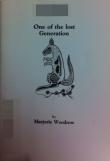 This image has been sourced from Front coverSee full AustLit entry
This image has been sourced from Front coverSee full AustLit entry'When I went home to find how my people are still living makes my blood boil, see they are still suffering, to have leaned that my great Auntie had helped to do how language, Ngiyambaa, and never was paid for it was a shock to me...' (Source: One of the Lost generation, 1998:5)
(...more) -
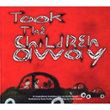 This image has been sourced from online.See full AustLit entry
This image has been sourced from online.See full AustLit entry'"Took the Children Away", is a moving indictment of the treatment of indigenous children from the 'Stolen Generation' and a song which 'struck a chord' not only among the wider Aboriginal community, but also nationally. The song was awarded two ARIA Awards, as well as an international Human Rights Achievement Award, the first time this had been awarded to a songwriter because of a song. The album it came from featured in Rolling Stone magazine's Top 100 Albums for 1992.
(...more) -
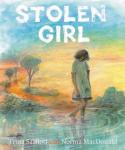 Courtesy of Magabal BooksSee full AustLit entry
Courtesy of Magabal BooksSee full AustLit entry'The story of the nameless fictional character in Stolen Girl, carefully and cautiously points out through text and images, the differences between life in the home she removed to (dorm life, routines, no family) to the family life she misses and dreams about (storytelling around the campfire, mornings with her mother on their verandah, fishing and swimming in the river).' Source: Heiss, Anita. Anita Heiss Blog, 14 March 2011. Sighted 16/3/2011)
(...more) -
 Image courtesy of Magabala BooksSee full AustLit entry
Image courtesy of Magabala BooksSee full AustLit entry'An action packed novel set in North Queensland, based on a true story. A boy and girl are on the run, chased by the police who want to take them from their mother. Their father, escaped from prison, is rallying local tribes for full scale warfare. An excellent account of the interactions between Indigenous people and white settlers.' (Source: TROVE)
(...more) -
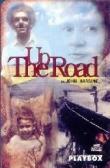 This image has been sourced from online.See full AustLit entry
This image has been sourced from online.See full AustLit entryA celebration of life, love and family set in the remote Aboriginal community of Flat Creek, where life is pretty uncomplicated—until a Canberra bureaucrat returns home. (Source: Australian Plays website)
(...more)First produced by the Ilbijerri Aboriginal and Torres Strait Islander Theatre Co-operative, Melbourne, 1991.
-
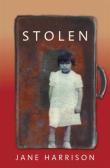 Cover image courtesy of publisher.See full AustLit entry
Cover image courtesy of publisher.See full AustLit entryStolen is based upon the lives of five Indigenous people, who go by the names of Sandy, Ruby, Jimmy, Anne and Shirley, who dealt with the issues for forceful removal by the Australian government.
(...more)Written for the Ilbijerri Aboriginal and Torres Strait Island Theatre Cooperative. First produced by Ilbijerri and Playbox Theatre Centre in association with the Melbourne Festival at the CUB Malthouse, Melbourne, 21 October 1998.
-
Mother Courage and Her Children translated and adapted by Wesley Enoch and Paula Nazarski from Bertolt Brecht's 1939 play 'Mother Courage & Her Children'.
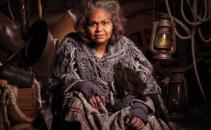 This image has been sourced from online.See full AustLit entry
This image has been sourced from online.See full AustLit entry'Bertolt Brecht's epic morality tale about the ravages of war is given a unique twist by Queensland Theatre Company Artistic Director Wesley Enoch and Paula Nazarski in a dazzling new translation.
Instead of the 'Thirty Years' War of 1600s Europe, this near-future incarnation of the age-old story is set against the bleak backdrop of a post-apocalyptic desert where Mad Max might be at home - an Australia ravaged by devastating conflict, where life is cheap but business is still business.
(...more)Performed at the Playhouse, QPAC, Queensland Performing Arts Centre, South Brisbane 25 May to 16 June 2013.
-
This play was workshopped at the National Playwrights Conference in 1991 and performed at the Araluen Arts Centre, Alice Springs, March 1992.
-
Women of the Sun directed by James Ricketson, David Stevens, Stephen Henry Wallace and Geoffrey Nottage
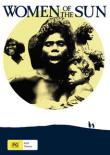 Image from Wikimedia CommonsSee full AustLit entry
Image from Wikimedia CommonsSee full AustLit entryA ground-breaking television series, Women of the Sun was, according to Moran in his Guide to Australian TV Series, born out of co-writer Sonia Borg's desire for a more balanced televisual representation of Indigenous Australians: 'Angry at the plight of Aborigines, she was concerned that many scriptwriters could conceive of Aboriginal women only as prostitutes.' To counter this tendency, she contemplated a series that showed Australian history from the perspective of Aboriginal women, a project for which she sought the colloboration of sociologist and social worker Hyllus Maris.
(...more) -
Us Taken-Away Kids: Commemorating the Tenth Anniversary of the Bringing Them Home Report edited by Christina Kenny
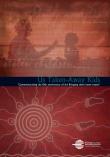 This image has been sourced from front coverSee full AustLit entry
This image has been sourced from front coverSee full AustLit entryIntroduction states: 'To commemorate the 10th anniversary of the publication of the Bringing Them Home report (1997), it is fitting that we should look to those whose stories of removal formed the basis of the report and its recommendations. With this in mind, the Human Rights and Equal Opportunity Commission invited Indigenous peoples across Australia to tell us their experiences of removal, their thoughts ten years on from the Inquiry and their hopes for the future.
(...more) -
Been a Lot of Change But The Feeling Is Still There: A Book About the Pain of Being Taken Away and the Celebration of Rediscovering Family edited by Wangka Maya Pilbara Aboriginal Language Centre
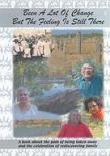 This image has been sourced from online.See full AustLit entry
This image has been sourced from online.See full AustLit entryA brief collection of autobiographical works, including stories about being taken away, about mission life, and about being reconnected with family.
(...more) -
The Colour of My Skin: Stories by Stolen Generation Survivors by True Stolen Generations Survivors Group
 Image courtesy of publisher's website.See full AustLit entry
Image courtesy of publisher's website.See full AustLit entryThe Colour of my Skin is a children's book that tells stories from Stolen Generations members in the Albury Wodonga and Woomera area, a group known as the 'True Australian Aboriginal Survivors'.
(...more)'This book was made possible though the generous commitment of the True Australian Aboriginal Survivors Group and a strong partnership between Albury Wodonga Aboriginal Health Service and Woomera Aboriginal Corporation' (Source: front cover verso)
You might be interested in...

